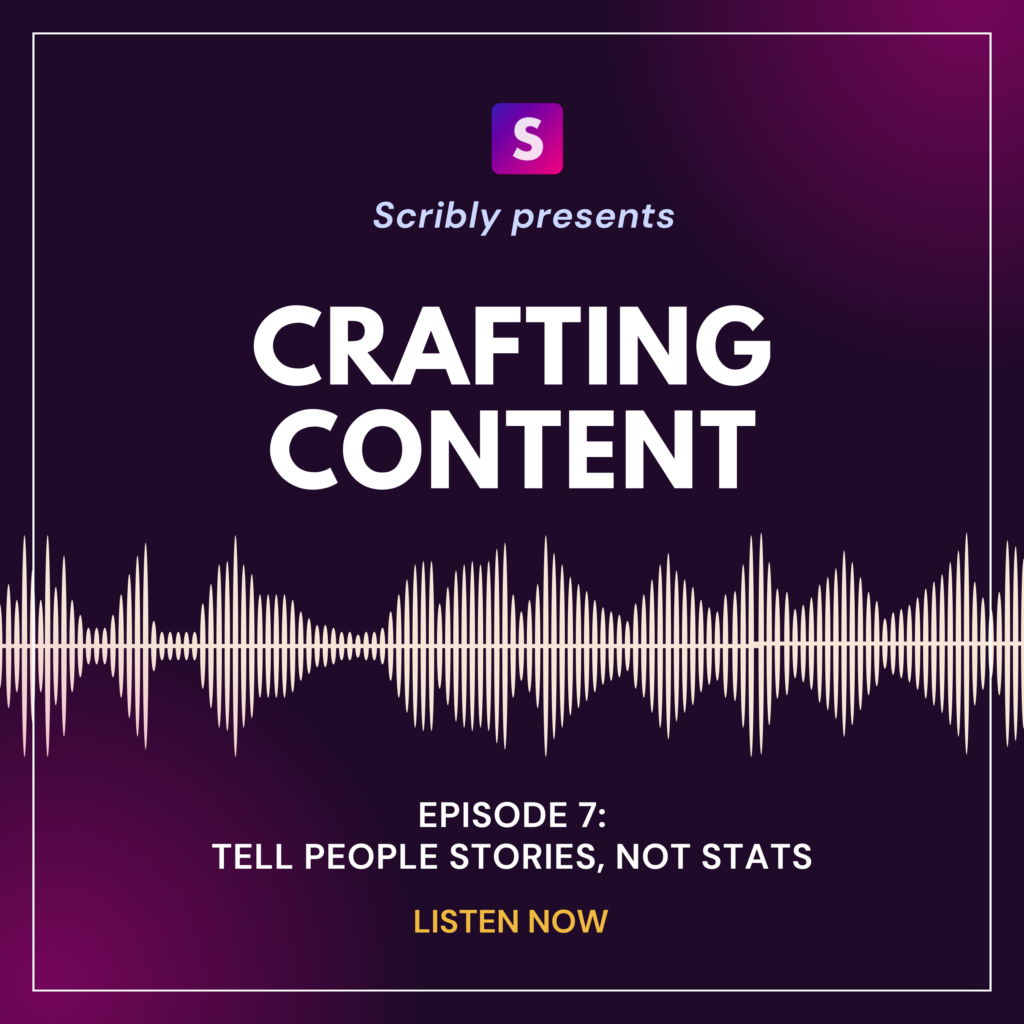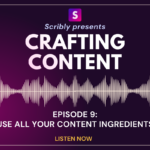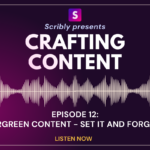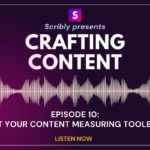Crafting Content – A content marketing podcast from Scribly
Crafting Content Episode 7: Tell people stories, not stats
The seventh episode of Scribly’s “Crafting Content” podcast is here! In this content marketing podcast, we share insights, top tips, and real-world examples to help you develop your content marketing skills.
Continuing on our “common content marketing mistakes” mini-series, today’s topic is about the power of storytelling. We discuss why storytelling is so memorable, how to bring storytelling to life across your digital and physical marketing efforts, and look back at some of our favorite, most memorable marketing narratives from brands like Apple, Patagonia, John Lewis, and more.

You can listen to the full episode here: Scribly’s Content Marketing Podcast Episode 7: Tell people stories, not stats
Episode 7: Tell people stories, no stats [transcript]
Taylor: Hello, and welcome back to Crafting Content, the Scribly podcast. I’m Taylor, and we are still talking about some common content marketing mistakes that we see. Joining me again for this episode are my coworkers, Elle and Alex. And, today we are going to be talking about the mistake of ignoring the power of storytelling, which seems like quite a lofty concept. So, what do we mean by that? Our in-house content writer extraordinaire, Alex, can maybe illuminate this mistake for us a little.
Alex: Try. I can try. I think it sounds lofty, but it definitely doesn’t have to be, because when we’re talking about stories, everything’s a story, right? So even if you’re writing a blog post about the most mundane thing, you can turn it into a quote-unquote story or journey that you’re taking the reader on. So we’re not talking about writing the next great novel in your content marketing. It’s more about weaving a thread through the things that you write that takes the readers on a journey, that gives them characters to root for, if possible, and that appeals to their emotions. I think those are the main three things that you would be looking at when you’re talking about storytelling and content marketing.
Taylor: Picking that apart a little bit, what would be an example of emotional marketing or emotionality in content marketing?
Alex: Yes, I think it can be overlooked. I think talking to people’s emotions when you’re doing marketing because often you can view it as just delivering information, or letting people know about a product, or summing up the news, or whatever you’re doing with that piece. But appealing to emotions is what makes us connect with things, and it’s what makes things stick in our heads. So, a great example of this is the John Lewis Christmas advert, which, for people who aren’t in the UK or don’t know what that is, John Lewis is a department store in the UK. And every year they have a Christmas advert that’s not just an advert in the traditional sense anymore. They create what I’ve seen described as a mini movie, and they’re often a little bit sad which is a great way to get people to, one, connect with the message, and two, remember what it was. They’re a bit sad, but they’re also hopeful and happy at the end. So I think a big part of the appeal of those adverts is that they’re not just saying “Hey, look, here’s what we’re doing this Christmas as John Lewis come down and get a new toaster for 30% off”. It’s “Look at this man on the moon. Isn’t he lonely?”. Oh, actually, no, it’s nice because it’s Christmas and his friends and family are there. So it’s the emotions that you remember rather than the fact that it’s a Christmas advert for a department store.
Taylor: Yeah.
Elle: And I guess in that sense, they’re using the storytelling of the advert itself to then tell the story of their brand.
Alex: Exactly.
Elle: Which is, we’re not just a department store that sells but we create a sense of unison amongst family members. So because I’m British as well, and know every John Lewis advert that’s ever existed, my favorite is the one, and it’s probably the one that makes most people cry. There’s a little boy who, for the lead up until Christmas, you just see him, like, watching the clock and it’s ticking really slowly and he’s sat really nervous and his legs are always jiggling and he’s just constantly looking, waiting, and puffing because the days leading up to Christmas are going far too slowly. And obviously, the assumption as you’re watching is that he’s a little boy and he’s really excited to open all his presents on Christmas day and then cut to Christmas day. All of his presents are laid out at the foot of his bed, and he runs past those presents into his wardrobe, grabs a parcel that he has very clearly wrapped himself, and runs into his parents’ room. And he wasn’t excited to get his own presents. He was excited to give the gift of Christmas. And it’s that storytelling that then, one, is very memorable in an advert in itself, but two translates that story of John Lewis as a brand of “we produce things you want to give”, and it’s using storytelling to then tell the brand story, if that makes sense.
Alex: Yeah. And I think that also, touches on the point, I was saying, about taking the reader or the viewer or whoever on a journey and having characters as well, because those are a couple of other good ways to make it stick in someone’s head because you’ve just recounted the entirety of that advert, including the characters involved, and that was from what, five years ago or whatever.
Elle: It’s definitely an old.
Alex: Yeah, yeah. And so it’s like any. Can we remember that it was Sam and Frodo who walked to Mordor, or Harry Potter who went to Hogwarts or whatever. You have characters that your brain can latch onto, that you can empathize with, that you can root for, and you have a plot almost. And that, again, doesn’t just have to be restricted to a story in the traditional sense, like when you’re writing a blog or an ebook or something, if you can figure out beforehand the story that you want to tell, with that and the journey that you want to take the reader on, whether there’s a larger point you’re trying to make or whether it’s just, here’s the basic information and here’s the more detail that we’re going to go into. It just gives what you’re doing more cohesion and more of a narrative that the reader can follow and latch onto and hopefully engage with on a deeper level than just a pure list of facts, I suppose.
Taylor: What might that look like in a blog post? How do you create characters in a blog post about a product that you want to sell or educate people about?
Alex: I think you can do it in a few different ways. I think. So one of the best characters that you can create would be the reader themselves. If you’re talking about a product, you can talk about how that product would impact the reader or people around them, or just people in general in their day-to-day lives. So, I don’t know, if you’re selling a water bottle, because I’ve got one on my desk and I’m looking at it. You can talk about how the product relates to the person reading it as opposed to “This is our bottle. It has this nozzle and it holds one liter, and you can fill it with water or milk”. Instead, you can say it has this nozzle, which will allow you to more effectively hydrate. And it holds a liter so you can stay on the move. And it’s just relating it back to the person who’s reading it. So I think that’s a character you can use in a sense. The other thing is, are there any characters inherent in what you’re writing about? So if you’re writing about, for example, the climate crisis, say, to pick a light and fun topic, you can talk about the countries involved and what they’re doing to help, or you can talk about the animals and how they’re affected by it. And you can position those aspects as characters within the story that you’re telling rather than just as entities. You can give them more personality, use more emotive language around them. Again, refer to how these are affecting them on a real level rather than just as abstracts. It’s, I guess, I suppose, about finding the places that you can humanize different parts of what you’re writing about.
Taylor: So on a larger scale, how can you use storytelling to tell the story, so to speak, of your brand?
Elle: Alex, if you don’t mind, I’ll take this. This entire job is to sell the story of Scribly, and then help from a strategy perspective. Brands sell their stories as well. I think that’s the key difference between advertising and marketing and what it comes down to. So advertising is, hey, we’ve got this product, here’s why you’ll like it. And marketing is about storytelling. If you’ve got a brand, I’m going to use an example of skincare products. And rather than saying, we’re scientists and we like skincare products, here’s a face scrub that you might like. You can use storytelling to highlight where that brand came from and the values that it has, the driving force behind it. So you might say instead, after struggling with psoriasis for 15 years and being on and off medication and various treatments, I couldn’t find a solution that worked. So, I went off, did some research into natural ingredients, started making them from my kitchen table, experienced great results, and wanted to share that with the world. And that expanded from my kitchen table to my garage and my garage to a small process center in London or whatever your brand story is. But it’s that thing that people will then remember as opposed to “Oh, there’s that brand that sells that psoriasis cream”. Instead, it’s “there’s that woman who found a solution to all their problems and is sharing it with the world”, et cetera. So I guess storytelling comes into branding so much.
Taylor: I mean, Apple started in Steve Jobs’ parents’ garage and now they’re the trillion-dollar tech behemoth.
Elle: I think Apple is such a good example as well. They bring storytelling even into the experience of their products. So like when you open up whatever you’ve purchased, whether it’s a Mac or like headphone box, whatever, but you pull it up, you pull the lid off really, really slowly and it has that suctiony, dramatic, slow fall, and then it unveils your product, which is always beautifully wrapped. And everything’s very meticulous. And it’s all about the experience, I think, in itself, that tells the story of the love and care that goes into packaging these products. And they even use it in their physical marketing as opposed to just their written marketing as well.
Taylor: It’s been written about somewhere that they tested tons of different boxes for the first iPhone, to get the opening rate to be a certain set amount of time, really, just so you get that experience.
Elle: Very effective tool. Proof, we all remember it and all talk about it.
Alex: There you go.
Taylor: Yes. Are there any other examples of companies or specific marketing campaigns that stick in our minds?
Alex: So one that comes up for me is the Patagonia one, the “Don’t buy this jacket” campaign that they did.
Elle: Oh, yeah, the Black Friday one, right?
Alex: I think it was Black Friday, yeah. So, yeah, for those who don’t know, they put an advert in—was it the York Times? Yeah, yeah. So they put a full page advert in the New York Times with a picture of one of their jackets saying, don’t buy this jacket, which seems like a backwards way of advertising your products. But the point they were trying to make was that we need to be more conscious about the rampant consumerism that defines our culture at the minute and we need to be more thoughtful with what we’re buying, with the waste we’re creating, and with the damage we’re doing to the environment. And so by saying, don’t buy this jacket, they were hoping to get people to think about their spending habits and their consuming habits, whilst also putting themselves in the conversation. Because at the same time, while that seems like a backwards way to advertise things, there’s that old adage that there’s no such thing as bad publicity. So even if you’re giving yourself bad publicity by saying don’t buy our stuff because we’re destroying the planet, we’re talking about it. I know it was Patagonia that made it. And now everybody who’s listening also knows that Patagonia did, that it’s also.
Elle: Such a powerful way to tell a story. Right? It’s what, four words? And yet if we go back to the idea of it being a story that showcases your brand values. Yes. Objectively, they’re saying, don’t purchase this, don’t fall into the trap of discounts and mass consumerism, but it’s also highlighting their values. Right. So it’s saying, we don’t agree with that. We want to look at more ethical ways of fighting against fast fashion or whatever core values that they have in that instance. But it’s four words that tell a whole story of what they’re going to stand for moving forward. And I guess it’s that story that people remember as well.
Alex: Yeah, 100%.
Taylor: And then since they’ve run that ad, at the time they ran it, their company mission was slightly different, and since then, they’ve changed it. At the time they ran the ad, they said, it’s part of our purpose to inspire and implement solutions to the environmental crisis. Since then, since it ran, they’ve changed it to, we’re in business to save our home planet.
Elle: I got goosebumps then.
Taylor: They’re bringing these brand values and brand missions into their marketing, and they’re signaling and saying to their customers “And you can be a part of that. You can be a part of helping us help save the planet”. And that’s also something that’s really, I think, valuable because you’re making a team between you and your customers. You’ll be like, we can do this together, guys.
Elle: It’s leaning back on that emotional marketing that Alex was talking about, and it is so intertwined with storytelling—creating a sense of responsibility and a sense of unison.
Taylor: Yeah, exactly. One that I think is really interesting is Spotify’s annual wrapped campaign. It’s funny because it doesn’t feel like marketing, but it definitely is.
Elle: It’s such a clever way of doing it.
Taylor: Yeah, it’s really smart. And I think that what’s really clever about it is they’re saying to you, “Hey, this is your musical life for the past year”. You get to see your most played song, most played artist, most played album genre. You’re reliving all those moments where you’ve sat there listening to these things, but they’re also saying, “Hey, while you were doing all that, you were using Spotify, you were using our product, and we helped you do that. We helped you make those memories, experience this music, and discover these new artists that you now love and are playing over and over again”.
Elle: It’s also the shareability of those stories. Right. Like, everyone gets a Spotify wrapped. I think now there’s even the option to download the images. But I think previously people used to just screenshot them. I think they were on your Instagram story. It was about sharing that story of, “Hey, this has been my music journey. What’s yours been?” And it’s wanting to partake in that again. That kind of, I guess, emotional bonding, a little bit of judgment from people but in quite an endearing way. It’s such a clever way of associating when they bring that Spotify wrapped back and you’re reminded of “Oh, yeah, I did go through a month of over-listening to Hamilton”. And then you remember why. And then you’ve then got a story to tell. And as you’re telling that story, you’re obviously promoting—unconsciously—Spotify itself. So it’s like a two edged sword of, they’re reminding you of your journey, but encouraging you to share your stories and associate it with their brand.
Alex: Yeah, I mean, they’re telling you your story, right. Instead of Spotify’s story, it’s your story that they’re telling back to you.
Elle: Yeah.
Taylor: Which is a really unique approach to things that obviously won’t work for every brand. But if you can find a way, and a great way to do that is through customer testimonials or experiences and say “Look how instrumental our product was in Janie Smith’s life” or whatever it might be, to really humanize your offerings.
Elle: So at the start of this, Alex, having argued that actually, storytelling isn’t that big of a space for us to talk about, we’ve gone into a lot of different.
Alex: Yeah, yeah.
Elle: But if we wanted to summarize, Alex, the key points are that storytelling is what people remember because they have that emotional connection. And, it can be used in lots of different and very clever ways throughout your different marketing approaches.
Alex: Yeah, I think so. I think it’s about finding a narrative, finding characters, and finding the emotion— those are the three key things that you’re looking for.
Taylor: I’m sure this is a topic that will come up again and again and certainly has done for many of our clients in the past. So stay tuned and you might hear more tips and tricks about it in the future. And speaking of the future, we will be back for another episode soon, about more content marketing mistakes. And, we look forward to seeing you there.
Thank you for listening to Crafting Content, a content marketing podcast from Scribly. You can find more information about what we cover today in our show notes. Scribly is a content marketing agency that helps you boost traffic, generate sales, and increase your bottom line. With our end-to-end service, we take care of everything from content audits and strategy to content creation and management across websites, blogs, socials, and email. We’re a small but mighty team of experienced strategists and marketers who specialize in content creation. If you want to learn more about how Scribly can help your business, please get in touch. You can find more information and send us a message on our website, scriblymedia.com. We’d love to hear from you.




